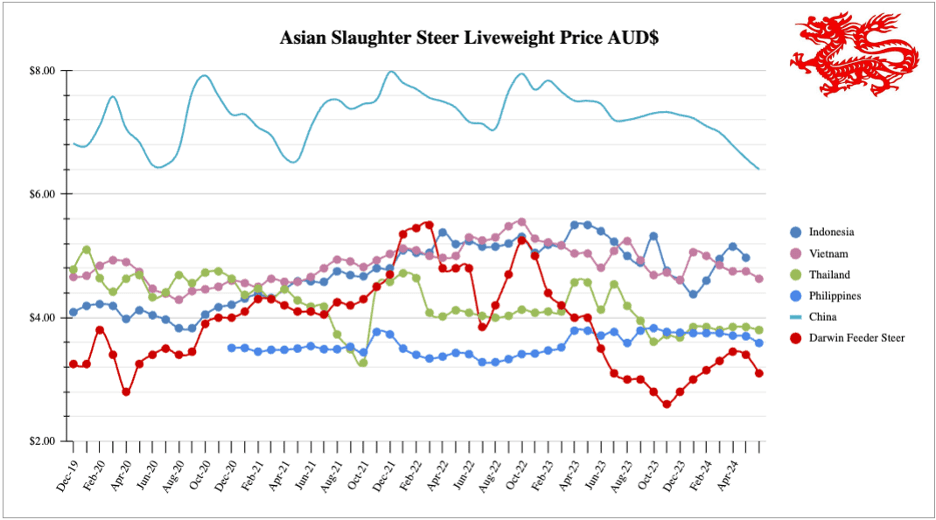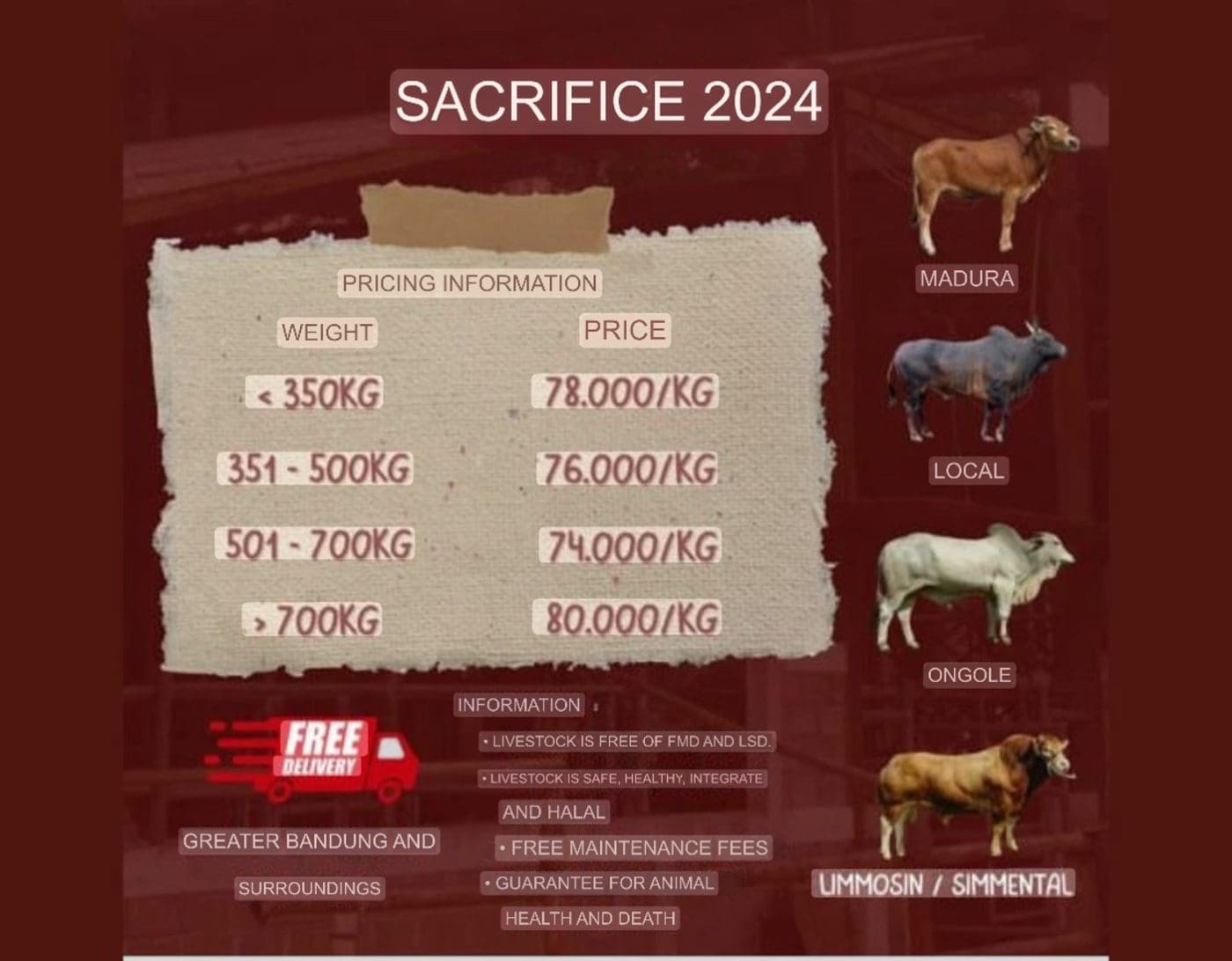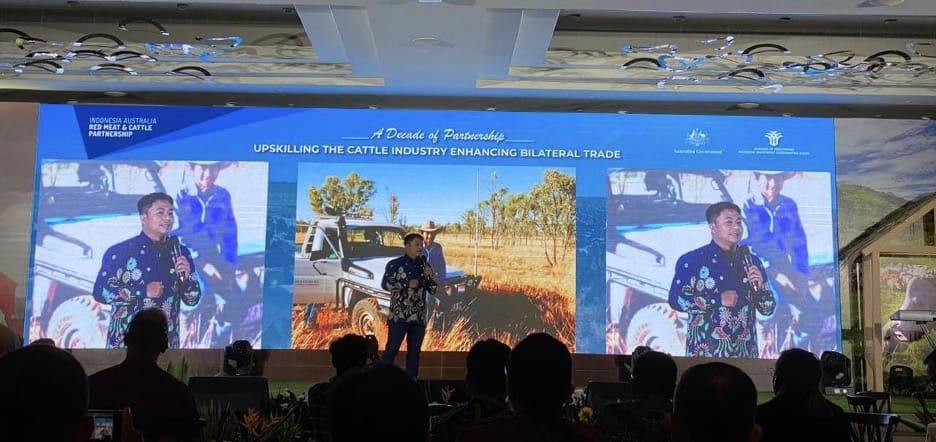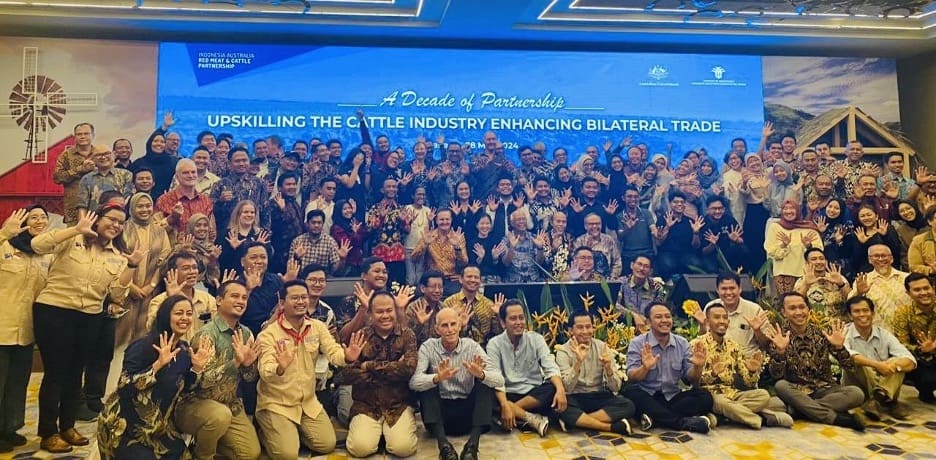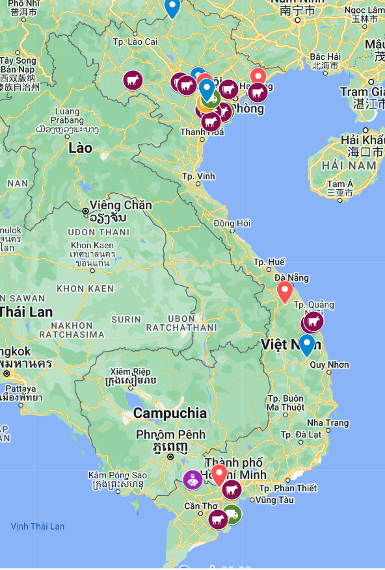
126th Edition: June 2024
Key points:
- India and Indonesia elections should be positive for regional stability and growth
- Indonesia moves cattle in preparation for Qurban (Festival of Sacrifice)
- RMCP ends its Aus-Indo 10 year $60mil support program
Regional Trends and Overview
The recent elections in India and Indonesia hold significant implications for both regional dynamics and Australia’s interests.
In India, the 2024 elections resulted in Prime Minister Narendra Modi’s Bharatiya Janata Party (BJP) securing 240 seats, falling short of the 272 majority needed to govern alone. This marks a substantial decrease from the 303 seats won in 2019. The BJP will now rely on coalition partners to maintain power, highlighting a shift towards a more balanced political landscape. The opposition, led by the Congress Party, which increased its seat count from 52 to 99, views this outcome as a moral victory and a mandate for more inclusive governance.
For Australia, this change could foster a more stable and predictable business environment in India, as the need for coalition governance may encourage more consensus-driven economic policies. Australia’s trade relationship with India, particularly in sectors like education, agriculture, and technology, could benefit from India’s anticipated focus on job-intensive growth and skills development.
In Indonesia, Prabowo Subianto’s administration aims to continue Indonesia’s “good neighbor” policy, emphasizing stable relationships with Southeast Asian nations and major global powers like the United States, China, and Australia. However, Prabowo’s past reputation for ultra-nationalist and chauvinistic views might pose challenges in maintaining consistent diplomatic engagements with Western countries, including Australia. Despite these concerns, Prabowo has expressed a commitment to fostering positive bilateral relations, indicating a desire to build on existing diplomatic foundations laid by his predecessor, Joko Widodo.
Prabowo Subianto’s victory in the presidential election signifies a continuation of the economic policies initiated by his predecessor, Joko Widodo. Prabowo plans to further the “commodity downstreaming” policy, which aims to process raw materials domestically to add value. This includes the manufacturing of products like electric vehicle batteries from nickel, enhancing Indonesia’s economic resilience and attracting foreign investment.
Australia, which shares robust trade and investment ties with Indonesia, stands to benefit from Indonesia’s drive towards high-income status and its potential membership in the Organisation for Economic Co-operation and Development (OECD). These developments could lead to more significant trade opportunities and collaborative ventures in sectors like mining, energy, and education.
Overall, the political shifts in India and Indonesia highlight a move towards more balanced governance, which could provide a stable foundation for economic growth and bilateral relations with Australia. This period of change offers Australia a strategic opportunity to strengthen its economic and diplomatic ties with these key regional players.
Indonesia: Slaughter Steers AUD $4.70 / kg live weight (IDR 10,797 = 1 AUD)
Beef Prices
As of June 2024, the market price for beef remains stable, ranging from $12.50 to $13.24 AUD (135,000 to 143,000 IDR) per kg. However, carcass prices have slightly decreased from a minimum of $9.72 AUD per kg (105,000 IDR per kg) last month to between $9.12 and $9.36 AUD (98,500 to 101,000 IDR) per kg this week. This drop could be attributed to a decrease in the price of corn (feed grade), which fell from $0.78 AUD (8,390 IDR) per kg in late April to $0.51 AUD (5,500 IDR) per kg in May 2024.
The latest regulation from the National Food Agency (BAPANAS, 2023) on beef price caps aims to stabilize the market and protect consumers.
Eid al-Adha/Idul Adha (Qurban Festival) 2024
Local Indonesian Qurban slaughter weight cattle advertised at $7.04 AUD (76,000 IDR) liveweight. The premium on large animals makes a 700 kg brahman bull potentially worth just over $5,000 AUD.
Livestock Mobility and Supply Chain
The Muslim Idul Adha (Qurban) celebration this year falls on June 17, leading to an increase in inter-island livestock mobility since last month. Many cattle in Indonesia’s major cities come from the eastern part of the country. By mid-May 2024, the West Nusa Tenggara (NTB) Province had shipped 29,009 local cattle to various regions in Indonesia. This includes 3,043 heads to DKI Jakarta, 20,645 to West Java, and 3,160 to South Kalimantan. The NTB Provincial Government has set a quota of 54,900 cattle and buffaloes for the year, with 25,891 heads still to be shipped. To date, 31,445 heads, including 2,436 buffaloes, have been transported. Farmers must obtain a veterinary certificate and a recommendation from the NTB Provincial Government (Animal Husbandry and Animal Health Service/Dinas) before shipping their livestock.
East Nusa Tenggara (NTT) is another province supplying Qurban cattle to other islands. So far, 12,176 cattle have been shipped to Sumatra, Java, and Kalimantan, with more shipments planned. However, in Kupang NTT, farmers have voiced concerns about new regulations requiring cattle to weigh at least 275 kg before being shipped, which prolongs the fattening period and increases costs. Additionally, the price per kg live weight this year is only AUD 3.61 (39,000 IDR), down from AUD 3.80 (41,000 IDR) last year, leading to minimal profits or even break-even situations. There are also fewer traders (middlemen) seeking slaughter-size cattle compared to last year.
Farmers in Lampung, another cattle supplier province, are also facing issues. They are hesitant to sell Qurban cattle in open markets in cities like Jakarta due to the risk of disease transmission. In 2023, unsold cattle could not be returned to their farms, forcing farmers to sell them cheaply, sometimes resulting in disease transmission during transit.
National Food Agency (Bapanas) Intervention
The National Food Agency (Bapanas) is addressing the issue of unsold livestock in the Greater Jakarta Area post-Eid al-Adha. In 2023, 2,152 cattle remained unsold and could not be returned to their origins. Bapanas is coordinating with state and regional enterprises to absorb these animals, preventing losses and stabilizing beef supply and prices.
Receiving Provinces’ Measures
Provinces in Java, such as DKI Jakarta and Yogyakarta, have been ensuring that imported local cattle are vaccinated and have appropriate clearance documentation. These inspections are conducted by the city-level government (Food Security, Marine Affairs, and Agriculture Agency Dinas/KPKP). The DKI Jakarta government estimates that around 63,000 Qurban animals from various regions will enter Jakarta ahead of Eid al-Adha. To prevent roadside sales, they have provided sale yards with shade, water, and feed troughs.
In West Java, the demand for sacrificial animals (Qurban) is expected to increase by 12 percent compared to 2023, reaching around 350,000 heads. This rise is attributed to economic improvements and the control of animal diseases like Foot-and-Mouth Disease (FMD) and Lumpy Skin Disease (LSD). The demand in West Java was 219,000 heads in 2021, dropped to 216,000 in 2022 due to FMD and the pandemic, but surged to 316,000 in 2023.
Online Qurban Trends
Online Qurban sales are also trending, with major online marketplaces like Tokopedia and Shopee, along with well-known non-profits such as BAZNAS and Dompet Dhuafa, offering the convenience of online purchasing with and without delivery services. Buyers can also choose a Qurban slaughter service system where the institution handles the distribution of animals if buyers cannot deliver them to the nearest mosque.
Indonesia-Australia Red Meat and Cattle Partnership Wrap-Up Event
Yudhistira Pratama S., of Halleen Australasian Livestock Traders presents on his experience as a participant in the NTCA Indonesia-Australia Pastoral Program
Last week, industry leaders and stakeholders gathered to reflect on the achievements of the Indonesia-Australia Red Meat and Cattle Partnership (RMCP). Programs such as the NTCA Indonesia Australia Pastoral Program (NIAPP), Forum of Animal Welfare Officers (FAWO), the Short-Term Australia Award on Biosecurity, and SISKA (palm-cattle integration) were highlighted for their significant contributions to the industry. Participants acknowledged the successes of these programs through knowledge exchange, capacity building, and improvements in cattle management and health practices which fostering stronger bilateral relations.
The tone of the meeting was both celebratory and contemplative, given it marked the end of the ten year, $60 million AUD program. There was an undercurrent of uncertainty about what lies ahead. Without confirmed future funding, the continuity of these impactful programs is in question, leaving stakeholders to ponder the next steps in the Indonesia-Australia cattle relationship.
Dairy Australia in Jakarta
In mid-May, leaders from Australia’s largest food and wine representative groups gathered in Indonesia to enhance trade opportunities. The Roundtable Discussion in Jakarta included delegates from Meat & Livestock Australia, the Australian Food and Wine Collaboration Group, and government officials, who exchanged insights on Indonesia’s market outlook and strategies for growth. Representatives from Dairy Australia were eager to position Australian dairy products as key to Indonesia’s plan to provide free school lunches.
Realities of the Indonesian Milk Program
Indonesia’s ambitious milk program, inspired by a similar Indian initiative, aims to provide free milk to 83 million schoolchildren. However, the program faces significant challenges. Up to 90% of Indonesians are lactose intolerant, leading to potential health issues like recurrent abdominal pain and diarrhoea. The program’s projected cost of AUD 13 billion annually also raises concerns about fiscal feasibility and potential corruption in the distribution process. Despite these hurdles, the involvement of Australian dairy could provide valuable support, leveraging expertise in dairy production and supply chain management to help meet the program’s goals.
Vietnam: Slaughter Steers AUD $4.63 / kg live weight (VND 16,910 = 1AUD)
Cattle and beef prices were stable, with our reported price dropping slightly due to the weakening Vietnamese dong. Live export figures from Australia to Vietnam have been high since the start of the year but have reportedly slowed down slightly as high demand from Indonesia competes for shipping space.
On May 24, 2024, a policy dialogue on “Sustainable Development for the Beef and Cattle Sector in Vietnam” took place within the Trade and Innovation Development Cooperation Project between Australia and Vietnam. Funded by the Australian Department of Foreign Affairs and Trade and the Australia-Vietnam Enhanced Economic Engagement Grant (AVEG), the event was organised by the Institute of Policy and Strategy for Agriculture and Rural Development (IPSARD) under Vietnam’s Ministry of Agriculture and Rural Development (MARD). Co-chaired by the Department of Livestock Production, Griffith University – Australia, FocusGroup Go, and Meat and Livestock Australia (MLA), the dialogue included 30 delegates.
Key topics included the development of grass-fed livestock farming in Vietnam, policies for the beef cattle industry, and trends in buffalo and beef consumption. Discussions focused on market and trade trends, advantages and challenges in managing beef and buffalo quality, live animal quarantine, disease safety, transportation, slaughtering, animal welfare, and greenhouse gas emissions (Source: Asian Beef Network).
The Asia Beef Network provides very good monthly coverage of Vietnamese beef and cattle market trends and insights including a regular reporting on price and an interactive price map tool above. Further information can be found here.
Philippines: Slaughter Steers AUD $3.59 / kg liveweight (P. 38.94 = 1AUD)
Another steady month in the Philippines with little change in prices. In wet markets and supermarkets alike, beef knuckle has been trading at $14.89 AUD/kg and $16.18 AUD/kg (P. 580/kg and P. 630/kg), respectively. Local cattle prices in Mindanao are still pegged between $3.34-3.73 AUD/kg (P. 130-145/kg) liveweight, and the hot carcass meat price is approximately $6.67 AUD/kg (P. 260/kg). It is important to note that these figures pertain to cattle bred and traded within Mindanao, not Australian imports.
Australia: Feeder Steers Darwin $3.10, Townsville $2.60
A very busy period for live exports over the last four weeks as the northern trade got in to full swing. Competition is fierce for shipping space with most exporters being able to lock in longer term charters on vessels thanks to a confidence that they will be able to fill them, and a need to secure space from competitors.
2024 Year to January figures for cattle sea freight across Asia by state
| Country | NT | QLD | VIC | WA | Grand Total |
| Brunei Darussalam | 819 | 819 | |||
| China | 30,402 | 1,904 | 32,306 | ||
| Indonesia | 48,548 | 49,963 | 1,800 | 29,070 | 129,381 |
| Malaysia | 1,200 | 1,200 | |||
| Philippines | 2,282 | 1,610 | 2,786 | 6,678 | |
| Vietnam | 20,219 | 9,648 | 29,867 | ||
| Grand Total | 51,649 | 70,182 | 35,012 | 43,408 | 200,251 |
Source: DAFF website
Year 2024 to January for cattle sea freight comparison across Asian markets
| Country | 2019 | 2020 | 2021 | 2022 | 2023 | 2024 | Grand Total |
| Brunei Darussalam | 5,021 | 8,237 | 13,005 | 5,335 | 3,282 | 819 | 35,699 |
| China | 157,787 | 129,637 | 96,826 | 140,651 | 78,723 | 32,306 | 635,930 |
| Indonesia | 668,941 | 464,077 | 409,036 | 338,200 | 359,305 | 129,381 | 2,368,940 |
| Malaysia | 16,630 | 21,386 | 17,566 | 3,896 | 4,326 | 1,200 | 65,004 |
| Philippines | 17,528 | 20,892 | 20,602 | 7,059 | 18,653 | 6,678 | 91,412 |
| Thailand | 1,669 | 1,736 | 2,060 | 1,772 | 1,674 | 8,911 | |
| Vietnam | 277,280 | 297,709 | 166,227 | 58,200 | 126,930 | 29,867 | 956,213 |
| Grand Total | 1,144,856 | 943,674 | 725,322 | 555,113 | 592,893 | 200,251 | 4,162,109 |
Source: DAFF website

